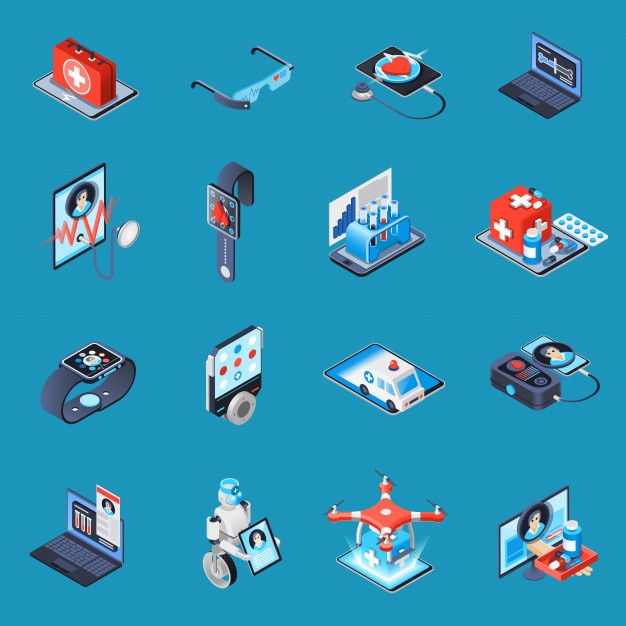Topic 2
Sectieoverzicht
-

The idea of talking to a doctor or a health care provider from a distance did not arise in the last century or the one before it, this idea has a long history and a lot of experience story that has designed different ideas and encouraged different people to develop a tool that can help to treat as many patients as possible.
In this first lesson, a small part of the history of telemedicine is introduced and we are also gone take a look at how Greece implemented telemedicine for the first time until now.

In 1860 the Telegraph was used for the first time in the war. William S. Morris and Albert James Mayer have developed a system to use the Telegraph to request medical supplies for the frontlines, specify delivery points and coordinate patient transport.
In 1874 in Australia was the first documented use of Telegraph for medical purposes. That happened when the Barrow Creek telegraph station was attacked. A police officer was seriously injured, a surviving policeman asked for help via the Telegraph. Dr. Charles Goose how was informed, gave instructions on how to treat the injured men through the Telegraph until an ambulance arrives.

The next case where Telegraph was used was in west Australia where a twenty-nine-year-old farmer fell off his horse, his friend took him to the nearest town hall (75 km), but there was no hospital or doctor in that city. Via the Telegraph they could reach a doctor who made a diagnosis. However, because the man had to undergo surgery immediately and due to the lack of medical devices, the man died shortly thereafter. The next day the story was on the front pages of all newspapers.
This story inspired John Flynn to develop the world's first Medical Aviation Service in Australia. This organization was organized in 1928 under the name Aerial medical service (AMS), this organization makes it possible to reach patients quickly in remote places in case of an emergency.
The founder of AMS has indicated that radio can reduce the work of AMS by 75%. However, the electricity was not optimal around this time. But Alfred Hermann invented the Pedal radio (a dynamo generator with a pedal drive that was used for electricity supply) at the beginning Morse codes were used and after 1930 was the sound massages were used.

In 1940, all AMS locations were provided with all the devices needed for telemedicine. With the further development of technology and the invention of television, the telemedicine system could further develop. In 1947, the TV was used for the first time to broadcast surgery to doctors in training. In 1951 the telemedicine system was further developed into a colored TV system. The system was also used for video conferencing this year. The cable television system connected in 1968 the university of Nebraska Medical Center and three hospitals for veterans (in Omaha, Lincoln, and Grand Island). Besides, the telemedicine system was further developed this year with devices such as the electrocardiograph, stethoscope, microscopy, voice, and other capabilities. (Vladzymyrskyy, Jordanova, & Lievens, 2016)
The twentieth century had an important role in the development of telemedicine, but the twenty-one century has also made enormous progress for telemedicine, Such as using a mobile phone to take medical care to a remote location, introducing the High-tech camera that makes teledermatology possible through clear photos of the skin and enabling teleradiology through radiographic images and making it possible to forward patient information easily and quickly to other healthcare providers far away.
Telemedicine and Greece
The Greek telemedicine program was started in 1989. the first impetus was between the Internal Medicine Department of the Sismanogleion Hospital and the first-line centers of Spata, the island of Paros, the Hospital of Karpenision and the Primary Care Department of West Fragista.
In 1990 the Greek health minister financed the installation of three terminals in primary health care, for which an agreement was signed with the Greek telecommunications provider (OTE). Two terminals were placed in Sismanogleion hospital one in the Medical Physics Laboratory of the National Kapodistrian University of Athens.

Isolated islands such as Limnos, Ikaria, Faros, Skopelos, Santorini, Astypalaia, Fourni and Kastelorizo were supported in 1992 with the telemedicine service. In April 1992 the connection of primary health care was complete. Afterward, 2000 cases were served.
Pneumatological: 27%
Cardiological: 17%
Orthopaedics: 21%
Ourology: 5%
Surgery: 2%
Supporting and Diet: 12%
The same year the regular teleconsultation service for medical diagnosis was established via the Sismanogleion Hospital Telemedicine Unit on different islands. The last development of telemedicine in Greece was in 1999 the country towards the design of an integrated national telemedicine action plan. This plan was implemented of the study in 1998 that was funded by the Greek ministry of health.
